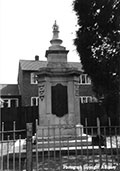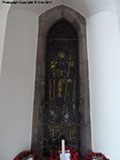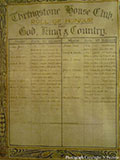Private Frank Brotherhood Bowler, 40136
- Batt - 1
- Unit - Royal Dublin Fusiliers
- Section -
- Date of Birth - 12/11/1895
- Died - 24/04/1917
- Age - 22
Add to this record?
If you have photographs, documents or information that can contribute to this record, you can upload here
ContributeSource: Michael Doyle Their Name Liveth For Evermore: The Great War Roll of Honour for Leicestershire and Rutland. He was the son of Thomas Bowler, born in the January quarter of 1868 in Shepshed, Leicestershire (son of James Bowler and Sarah Brotherhood) and his wife Arabella Bowler (nee McKinvien, married on the 18th January 1893 in Camlachie, Lanarkshire, Scotland) born on the 30th March 1859 in Perth, Scotland (daughter of James McKinvien and Eleanor Watt). Frank Brotherhood was born on the 12th November 1895 in Coventry Warwickshire and was baptised on the 26th March 1909 in St. Andrew’s Church, Thringstone, Leicestershire, he had one sibling, James, who was born on the 21st July 1893 in Coventry and baptised on the 26th March 1909 in St. Andrew’s Church, Thringstone. In March 1901 Frank was residing in Brook Street, Shepshed together with his sibling James, this being the family home of his Uncle, John William Peters, a shoe trade finisher, born 1876 in Whitwick, Leicestershire and his wife Keziah Peters (nee Bowler, married on the 17th September 1898 in St. Botolph’s Church, Shepshed), a shoe trade machinist, born 1873 in Shepshed. In April 1911 Frank was employed as an engineering works driller and was residing with his sibling, James, also an engineering works driller at The Star Inn, Thringstone, this being the family home of his Uncle, John Peters, a publican and his wife Keziah, assisting in the business, and their children, Ruby Irene, born 1906 and Edna I., born in the April quarter of 1911, both children were born in Thringstone, also residing in the family home was Frank’s cousin, Gertrude Ada Smart, a dressmaker, born 1885 in Ruddington, Nottinghamshire. In March 1901, Frank’s mother was a patient in the County Asylum in Hatton Budbrooke, Warwickshire and in April 1911 she continued to be a patient, and sadly in the January quarter of 1914 died there, aged 54, Arabella was interred in St. George’s Cemetery, Edgbaston, Warwickshire. In March 1901 Frank’s father was employed as a motor car fitter and was residing at In Court, 13, Spon Street, Coventry, Warwickshire, in 1924 he had been residing at 40, Stockton Road, Coventry and had been admitted to the Birmingham General Hospital, where he died on the 24th March, he was interred on the 29th March 1924 in London Road Cemetery, Coventry.
NOTE: Frank’s mother, Arabella McKinvien, married John Wilkie Leishman in 1885 in Greenock, Lanarkshire, Scotland, John was born in 1862, they had two children, John who was born in 1887 and Elizabeth, who was born in 1889, both children were born in Glasgow, Lanarkshire. Arabella’s husband John died on the 25th January 1891 in Lanark.
Frank’s Army enlistment documents do not survive, all that is known of his military service is that he enlisted in Coalville, Leicestershire into the Leicestershire Regiment and was allotted the service number 33563, at some point he was then transferred to the Nottinghamshire & Derbyshire Regiment (Sherwood Foresters), and was allotted the service number 80083, and finally he was transferred to the Royal Dublin Fusiliers and allotted the service number 40136. It is therefore unknown with which Regiment, or on what date Frank first embarked to join the British Expeditionary Force, however as he was not recorded on the medal rolls for the 1914-15 Star, it must be assumed that it was at some time after the 31st December 1915. Nothing further is known of his military service until he was reported to have been killed in action on the 24th April 1917, while serving with the 1st Battalion of the Royal Dublin Fusiliers. His body was never recovered and he is commemorated on the Arras Memorial in the Pas de Calais, France. Frank was awarded the British War Medal and Victory Medal.
The War Diary records: 24 Apr-17 – Firing Line MONCHY. Orders for general attack cancelled at 1.00 pm. Battalion to assault hill 0.2.d.8.5 at 4.00 pm. However owing to Brigade runner losing his way, orders regarding change in time of barrage did not arrive until after the action. 2 Companies detailed (“W” and “X”) made the attack (unsupported by our artillery) with great gallantry, and were faced by very heavy shell, Machine Gun and rifle fire. After stubborn resistance they were compelled to fall back on our original front line leaving 1 officer (2nd Lieutenant BYRNE) and 19 other ranks killed, 5 officers (Lieutenant’s TOOTH, REILLY, BARRY, HEGARTY and ROGERS) and 55 other ranks wounded and 37 other ranks missing in no man’s land. Thus, owing to there being no artillery support the task allotted to the Battalion was unaccomplished.
Source: Leicestershire War Memorials Project. Coalville Times article - Friday May 21st, 1920
THRINGSTONE WAR MEMORIAL
UNVEILED BY COL. BOOTH AT THE PARISH CHURCH
A beautiful stained-glass window has been placed in St. Andrew’s Church, Thringstone, in memory of men from the parish who fell in the war, together with a brass tablet bearing all the names, and the unveiling was performed by Col. T. Booth at a special service last Sunday afternoon, when there was a crowded congregation, which included many relatives of the deceased soldiers.
The service was impressively conducted by the Vicar (the Rev. C. Shrewsbury) and opened with the singing of the hymn, “There is a Land of pure Delight.” Other hymns sung were, “O God our help in ages past,” “The Saints of God,” and “For all the Saints,” also the psalm, “The Lord is my Shepherd.”
The window, which faces the church entrance, depicts St. Alban, the first British martyr to die for the Christian faith, and inscribed, “Christ’s faithful soldier and servant unto his life’s end.”
The tablet by the side of the window bears the inscription, “To the greater glory of God, and in memory of the following who from this parish and congregation have given their lives for their country in the great war 1914 – 1919, this window is dedicated by the congregation and parishioners of St. Andrew’s.”
Here are 27 names, as follows:
1914
Pte. T. Jones, Durham Light Infantry.
1915
Pte. E. Hall, Leicestershire
Corp’l W. E. Moore, R.G.A.
Pte. I. Hall, Leicestershire
1916
Pte. E. Howe, Leicestershire
Sapper E. Robinson, Royal Engineers
Pte. L. Whitmore, Leicestershire
Pte. T. Squires, Leicestershire
Pte. M. Grainger, Leicestershire
1917
Pte. F. B. Bowler, Royal Dublin Fusiliers
Pte. R. Freeman, Leicestershire
Sapper H. Briers, Royal Engineers
A. J. Turner, telegraphist, Royal Naval Volunteer Reserve
Pte. J. Squires, Leicestershire
Pte. L. Haywood, Scottish Rifles
Corp’l W. Sykes, Leicestershire
Pte. T. Bailey, Royal Scots
1918
Corp’l J. Bancroft, Leicestershire
Rfn. G. W. W. Howe, Rifle Brigade
Pte. J. Gee, York and Lancaster
2nd Lieut. T. F. McCarthy, Loyal North Lancashire
Pte. S. R. Dring, Leicestershire
J. T. Fortnam, Able Seaman, Royal Naval Division
L.-Corp’l A. Griffin, Sherwood Foresters
Pte. J. Morley, Suffolk
Pte. H. Freeman, Leicestershire
Pte. H. Lakin, Leicestershire
At the foot appear the words: “Greater love hath no man than this, that a man lay down his life for his friends.”
Having unveiled the memorial, Col. Booth proceeded to the other end of the church and from the chancel steps addressed the congregation as follows:
“My friends, I have been entrusted with the very solemn, but to me, the very proud duty, of coming here to address you, the members of this congregation on the subject of the memorial, that beautiful brass tablet which I have just had the honour to unveil, and I can assure you all that I am fully alive to the responsibility which that has involved upon me, and I am also very appreciative of the honour which it has imposed upon me. I am sure that as you heard those names read out, you could not fail to have been impressed, as I was, with the fact that these precious lives came from every class and from all ranks. What you may not have realised altogether is the width and scope of their sacrifice. I will try to explain what I mean. Reading out those names, I first find mention of men who went out at the start, in 1914, to help to stem the first wild onslaught of the Germans before we were ready; when everything was unprepared. Think of that. Then we pass on to other names of men who gave their lives in 1915, in those dull days in the trenches, when everything seemed dark, and when we appeared to be hammering our heads against a stone wall. Then I find more names in 1916, men who died in the great Battle of the Somme, which lasted for many weeks, but in which their services were rewarded by the first ray of hope which seemed to come to the nation. Then more names I find in 1917, men who took part in those hammering blows which we may regard as the period during which the war reached its height, when the storm seemed to be at its worst. Then in those terrible days in the early spring of 1918, I find more names, when the nation strained well-nigh to breaking point in her brave endeavour to stave off the last despairing effort of the Germans to overwhelm us on the soil of France. Lastly, and to me the most pathetic of all, are some few names of men who fell just as the dawn was breaking, a few days before the Armistice. Well, I have given a brief account of how those names covered that scope I spoke of at first. What then do we owe these men? I do not know whether you, or I, or anybody can yet appreciate the magnitude of that debt, but certain it is, we can never repay. What are we to do then – what must we do? Well, I think we must see to it that these men are never forgotten; that their names are never forgotten. This beautiful brass tablet and memorial window are the proof we intend to give that they shall not be forgotten. I think we must do more than this; we must see that we explain to the new generation that is coming on – explain to them what this tablet means; show them the names, and as they get older and more able to understand, explain to them what it stands for, what we really owe to these men; that we owe to them the peaceful possession of our houses, the freedom of the countryside to-day, the honour of our women and the safety of our little children. I think that is the duty for us in the future, and they will carry it on long after we are no more. Then, finally, I want to say a word to the members of this congregation who are relatives of the fallen. I know that nothing I can say is any real comfort; nothing that anybody can say is of any real comfort; but it may afford you some consolation to know that we, your fellow countrymen, are determined that the names of those beloved ones are not forgotten, and that brass tablet and window stand for all time as a witness to the noble and unselfish example of those brave souls, and I hope when you leave this church after this beautiful service, that you will feel as I do, and as all this congregation do I am sure, that their sacrifice has not been in vain.”
After the Benediction, the service closed with the singing of the National Anthem.
Research undertaken and submitted by Andy Murby, 24/5/2019
- Conflict - World War I
- Cause of death - KILLED IN ACTION
- Other Memorials - Shepshed Oaks & Charley
- Unit - Royal Dublin Fusiliers
- Former Unit n.o - 33563 - 80083
- Former Unit - Leicestershire Regiment - Nottinghamshire & Derbyshire Regiment (Sherwood Foresters)
- Cause of death - KILLED IN ACTION
- Burial Commemoration - Arras Mem., Pas de Calais, France
- Born - Coventry, Warwickshire
- Enlisted - Coalville, Leicestershire
- Place of Residence - The Star Inn, Thringstone, Leicestershire, England
- Memorial - SHEPSHED MEM., LEICS
- Memorial - ST. ANDREW'S CHURCH, THRINGSTONE, LEICS
- Memorial - COUNCIL SCHOOL MEM., SHEPSHED, LEICS



